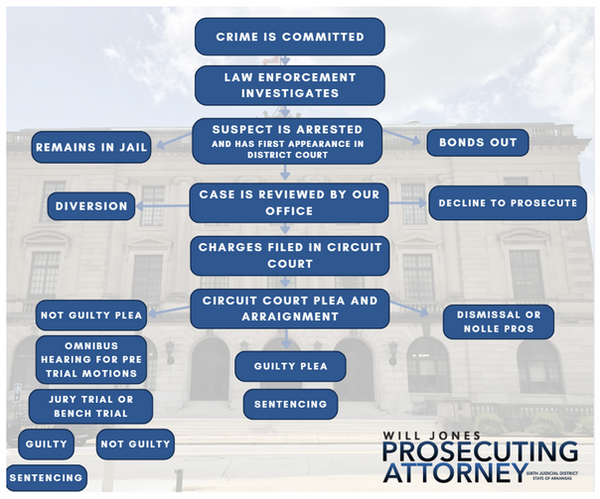
A CRIMINAL CASE
We know that the criminal justice system can feel overwhelming, confusing—even intimidating. We are here to help walk you through the process—from the moment a crime is reported to the final sentencing in court. Our goal is to break it down, answer your questions, and show how the Prosecuting Attorney’s Office works to keep our community safe and ensure justice is served.

Step One: Arrest
The criminal justice process often begins with an arrest. For many people, this is their first direct contact with the justice system.
An arrest happens when law enforcement has probable cause to believe a crime has been committed. This can occur in two main ways:
-
An officer witnesses the crime firsthand and makes an arrest on the spot.
-
An arrest warrant has been issued based on evidence presented to a judge, and you’re taken into custody later.
An arrest is not a conviction—it's the first step in a process designed to ensure due process, protect rights, and determine the truth.
Step Two: First Appearance
Following an arrest, the defendant will appear before a judge in District Court for what is known as the Initial Appearance. At this hearing, the court formally advises the defendant of the charges and addresses the issue of bond.
Under Arkansas Rule of Criminal Procedure 9.2, a judicial officer must first determine whether any non-financial conditions can reasonably ensure the defendant’s appearance in court. Only if those conditions are deemed insufficient will the court consider setting monetary bail.
If money bond is deemed necessary, the judge may order one of the following:
-
Surety Bond: A bonding company can post bond on the person's behalf — but by law, they must collect at least 10% of the total bond amount. (Ex: For a $5,000 bond, they would collect $500.)
-
Cash Bond: The full bond amount must be paid in cash to the court. That money is returned (minus fees) if the person shows up to court as required.
-
Own Recognizance (OR): In some cases, a judge may allow release without paying money, based on a persons ties to the community and likelihood of returning to court. It’s essentially a promise to appear.
-
When setting bond, the court considers several factors, including:
-
The defendant’s ties to the community
-
Employment status and financial resources
-
Criminal history and prior response to legal proceedings
-
The seriousness of the current charge
-
Any risk to public safety or the administration of justice
The bond determination process is a critical safeguard designed to balance the presumption of innocence with the need to ensure court appearances and protect the community.
When setting bond, the court considers several factors, including:
-
The defendant’s ties to the community
-
Employment status and financial resources
-
Criminal history and prior response to legal proceedings
-
The seriousness of the current charge
-
Any risk to public safety or the administration of justice
Step Three: File Decision Process
Once an arrest has been made and the initial appearance is complete, the case is sent through the file decision process. This step is crucial—it determines whether formal charges will be brought, and if so, which ones.
At this stage, prosecutors review all available evidence to assess whether the facts currently support filing charges. If there is insufficient evidence, the case may be declined.
Prosecutors also consider whether the defendant might be a good candidate for a diversion program such as Mental Health Court, PAC Court, or Veterans Court—especially in cases where underlying behavioral health needs are involved.
This step is about making thoughtful, informed choices that protect the public, respect the rights of the accused, and serve the interests of justice.
Step Four: Circuit Court Plea and Arraignment
After charges are filed the defendant will appear in Circuit Court for Plea and Arraignment. This is a pivotal step in the criminal justice process, as the defendant formally enters a plea.
At this stage, a defendant may:
-
Plead Guilty
-
Plead Not Guilty
-
Plead No Contest (Nolo Contendere)—not admitting guilt, but accepting conviction
If a plea of guilty or no contest is entered, the judge will either accept a negotiated pela or set a sentencing date.
If a plea of not guilty is entered, the case will proceed to trial, and a trial date will be scheduled. The defendant will be required to appear in court, prepared to present their case.
This step ensures that every defendant is informed of the charges and provided a fair opportunity to respond. It is also a critical point where many cases are resolved through plea agreements.
Step Five: Omnibus Hearing
The Omnibus Hearing is a critical pretrial proceeding in which the court addresses preliminary legal matters before a case proceeds to trial. This hearing is designed to ensure that both the prosecution and the defense have a fair opportunity to raise and resolve issues that could affect the admissibility of evidence, the scope of the trial, or the rights of the defendant.
Common matters addressed at an Omnibus Hearing include:
-
Motions to suppress evidence based on alleged constitutional violations
-
Requests for or disputes regarding discovery
-
Challenges to the admissibility of specific evidence or testimony
-
Scheduling issues and confirmation of trial readiness
In some cases, the Omnibus Hearing may also be used to revisit plea negotiations or determine eligibility for diversion programs.
This hearing serves as an essential safeguard, promoting procedural fairness, efficiency, and clarity before trial. It helps narrow the legal issues, ensures both sides are adequately prepared, and upholds the defendant’s right to a fair and timely trial.
Step Six: Jury Trial vs. Bench Trial
A jury trial is a formal courtroom proceeding where a group of citizens (jurors) are selected to determine the outcome of a case based on the evidence presented. This is a foundational right in the American justice system.
Before the trial officially begins, potential jurors are questioned by the judge and attorneys during a process called voir dire. This helps ensure a fair and impartial jury. Jurors may be excused for cause or by a limited number of peremptory strikes from each side. Once the final jury is selected and sworn in, the trial moves forward.
Here’s how it works:
-
Opening Statements – The prosecuting attorney presents an overview of the case and the evidence they intend to prove. The defense may follow with an opening statement or wait until later.
-
Presentation of Evidence – Witnesses are called to testify under oath. After direct questioning, they may be cross-examined by the opposing party. Physical evidence may also be introduced.
-
Closing Arguments – Once all evidence has been presented, both the prosecution and defense summarize their positions. The prosecutor goes first; the defense speaks last.
-
Jury Instructions & Deliberation – The judge explains the law to the jury, including how to apply it to the facts of the case. Jurors then deliberate in private to reach a unanimous verdict.
-
Verdict – The jury foreperson delivers the verdict in open court. If the defendant is found not guilty, they are released. If guilty, the jury will move into sentencing.
-
In a bench trial, there is no jury. Instead, the judge serves as both the fact-finder and the decision-maker. Bench trials are often shorter and may be used in certain types of cases or when both parties waive the right to a jury.
Here’s what happens:
-
Opening Statements – As with a jury trial, both sides present an outline of their case to the judge.
-
Evidence & Testimony – Witnesses testify under oath, and both sides may present evidence. The judge hears and evaluates all testimony directly.
-
Closing Arguments – Each attorney summarizes their case, pointing to the evidence that supports their side.
-
Judge’s Ruling – Instead of jury deliberation, the judge will review the evidence and legal arguments and then issue a verdict.
-
If the defendant is found not guilty, the case is dismissed and the individual is released. If found guilty, the court will schedule a sentencing hearing.
Bench trials are often chosen for legal issues that are better suited to judicial interpretation or when a quicker resolution is appropriate.
Step Seven: Sentencing
After a defendant is found guilty—either through a plea or trial—the case proceeds to its final stage: Sentencing.
At this hearing, the judge determines the appropriate consequences based on the offense, the defendant’s history, sentencing guidelines, and any victim impact statements or arguments from both sides.
Common sentencing outcomes include:
-
ADC (Arkansas Division of Correction): The defendant is sentenced to serve time in a state correctional facility.
-
SIS (Suspended Imposition of Sentence): A conviction is entered, but the sentence is not imposed so long as the defendant successfully completes all conditions imposed by the court. If violated, the court may revoke and impose the sentence.
-
Probation: The defendant remains in the community under court-ordered supervision and must comply with specific conditions such as check-ins, drug testing, or treatment.
Restitution may also be ordered if the defendant caused financial harm. This is money paid to victims to cover losses resulting from the crime (e.g., property damage, medical bills, or stolen funds).
Sentencing marks the conclusion of the court process—but accountability, supervision, and support often continue through probation officers, reentry services, and restitution enforcement.

